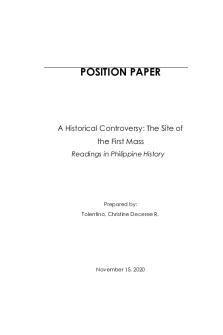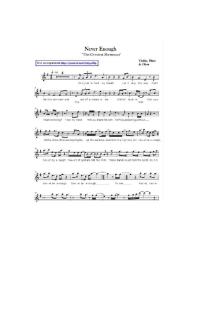Never caught paper - history PDF

| Title | Never caught paper - history |
|---|---|
| Author | Avery Foster |
| Course | Us Hist: Survey To 1877 |
| Institution | Texas Christian University |
| Pages | 5 |
| File Size | 114.4 KB |
| File Type | |
| Total Downloads | 18 |
| Total Views | 158 |
Summary
never caught essay over the book readings...
Description
Foster-1
The Resistance of Slavery Fredrick Douglass once said, “I didn’t know I was a slave until I found out that I couldn’t do the things I wanted.” “I freed a thousand slaves. I could have freed a thousand more if only they knew they were slaves,” Harriet Tubman wrote. 1 Slavery in this period took on a new demeanor. Those who suffered enslavement in the 1800s lived a toilsome and arduous life apart from any experience of freedom. Some did not try to escape the system for various reasons, while others spent their entire lives weaving together a plan to become free. The resistance was unique in the ways that enslaved people combated the institution of slavery. There were many methods of resistance, while some did not even resist unreservedly. Regardless, their choices speak volumes about the institution of slavery. The external slave trade sparked the slave trade and market within America. While the importation of slaves from Africa into the U.S. formally ceased in 1808, this did not stop the internal slave trade from rising in popularity. Enslaved people were bought and sold in between state lines. It was reported that there were about 72 million people actively involved in the slave trade during this era. The practices of the slave trade, even when it was internal, gives insight as to why a resistance was formed. The brutal market forced Africans into pens, where they would be held until their auction time. Moreover, they were even forced to eat more food while in containment so that they would appear healthier and more able-bodied. This was to ensure that they sold for higher prices, and malnourished slaves would likely be sold at a lower cost. Africans with lighter skin tones would sell for far more as well. If a particularly brutal and unkind slave owner was perusing the market, some slaves would hunch over in order to make
1
Quotes, Notable. “Quotations about Slavery.” Notable Quotes. Accessed October 22, 2019. http://www.notable-quotes.com/s/slavery_quotes.html.
Foster-2
themselves seem physically incompetent. Moreover, if they were out of earshot of their current owner, they would try to sound less intelligent when conversing with the potential slave owner. In some more extreme cases, some slaves would implement a limp into their walk to seem less desirable. They did all of this to ensure that they would not be bought by an unkind slave owner. This inhumane treatment of the Africans truly helps to explain why resistance became such a pivotal point in the slavery system. Oppositely, there were some slaves who did not want to leave the slavery system. Some enslaved people did not resist the system simply because they knew nothing else and wanted to remain close to their family. They knew that if one of them escaped, that one would be separated from his or her family. For example, in Never Caught by Erica Armstrong Dunbar, Ona Judge’s mother and father both worked, but this did not change the fact that they were a part of the slavery system. Her father was an indentured servant and her mother was a slave. 2 This goes to show that if someone was born into a family with two parents in the slavery system, they would more than likely become enslaved themself. This was the brutal truth of early America. For this reason, some would not even try to run free. The idea of being separated from their families was too much to bear. Because that life was all they had ever known, oftentimes, they would feel as if they were bound to a life in slavery in order to also be bound to their family. Ona Judge’s first exposure to free black communities affected her deeply. It also explains why some chose to resist their lives in captivity. As she watched their outright protests against the slavery system, she was moved. She had never seen such a thing in Virginia. However, this was simply the norm in the North. This was the case for many slaves who were exposed to the
2
Dunbar, Erica Armstrong. Never Caught: the Washingtons Relentless Pursuit of Their Runaway Slave, Ona Judge. New York: 37 Ink/Atria, 2018.
Foster-3
protests; they became inspired. Philadelphia was particularly eye-opening for Ona. When she saw the rallies, she was moved to plan her own escape. The free blacks appeared to be having a much better life outside of a master’s home. While Ona’s life with the Washingtons was not necessarily bad by any means (and truthfully, could be classified as one of the better lifestyles of an enslaved woman), she plotted to emancipate herself. Ona was inspired by the free black communities. Taking matters into her own hands, she waited for a window of opportunity. During a dinner party one night, when the Washingtons were preoccupied, she simply walked out of the house.3 Ona’s life as a free woman, however, was not what she had expected. Life outside of the mansion was difficult because she felt as if she had a target on her back. Upon her fleeing, the Washingtons felt shocked and betrayed. They offered a ransom for whoever could return her to them. Ona, at this point, had practically become a quintessential part of their lives. The Washingtons felt as if they could not live without her service around the house. Therefore, they advertised that they had lost a slave named Ona, sharing her physical description. Obviously, now Ona was forced to be incredibly careful as to who she trusted, as she did not want to be placed back into the slave trade. This is one of the reasons many slaves chose not to escape. They were able to realize that they were not “targets” if they stayed with their owners. 4 Upon her escape, Ona also had to change her lifestyle. She was forced to rid herself of the nice clothing that the Washingtons had given to her during her time serving them. If she was seen wearing fancy clothes, she may have been turned into the police for stealing, which would
Dunbar, Erica Armstrong. Never Caught: the Washingtons Relentless Pursuit of Their Runaway Slave, Ona Judge. New York: 37 Ink/Atria, 2018, 106-110 4 Dunbar, Erica Armstrong. Never Caught: the Washingtons Relentless Pursuit of Their Runaway Slave, Ona Judge. New York: 37 Ink/Atria, 2018, 115-136 3
Foster-4
eventually lead to her being returned to the Washingtons’ mansion. She also had to find her own food and place to live. All of these things were provided to her during her time with the Washingtons. 5 This lifestyle change is another reason that many slaves chose not to resist the system. Staying on the slave owner's property meant that they could have these privileges naturally. The transition could occasionally prove to be too difficult for slaves, so they would remain on the plantation and not join the resistance. Some enslaved people did not resist the system simply because they knew nothing else and wanted to remain close to their family. They knew that if one of them escaped, that one would be separated from his or her family. For example, Ona Judge’s mother and father both worked, but this did not change the fact that they were a part of the slavery system. Her father was an indentured servant and her mother was a slave. 6 This goes to show that if someone was born into a family with two parents in the slavery system, they would more than likely become enslaved themself. This was the brutal truth of early America. For this reason, some would not even try to run free. The idea of being separated from their families was too much to bear. In some very extreme cases, slaves would practice self-mutilation in order to not be sold. If they feared separation from their family, cutting off their fingers and making it appear to be an accident prevented them from being taken to market. Remaining on the property likely was better than having to go somewhere new to live with complete strangers and learn entirely new practices. Because this life was all they had ever known, oftentimes, they would feel as if they were bound to a life in slavery in order to also be bound to their family.
Dunbar, Erica Armstrong. Never Caught: the Washingtons Relentless Pursuit of Their Runaway Slave, Ona Judge. New York: 37 Ink/Atria, 2018, 140-142 6 Dunbar, Erica Armstrong. Never Caught: the Washingtons Relentless Pursuit of Their Runaway Slave, Ona Judge. New York: 37 Ink/Atria, 2018, 36 5
Foster-5
If circumstances within a slave owner’s property became too violent, or too controlled, revolts of the entire enslaved group would rise up in unison. Slave owners desperately wanted to avoid these large scale rebellions. If the revolts were successful, then the slave owner would lose his entire workforce. Some of the most notable rebellions were Denmark Vesey’s Conspiracy in 1822 and Nat Turner’s Rebellion in 1831. Within both of these retaliations, both leaders coerced the entire enslaved group on the slave owner’s property to escape collectively. Until recently, the United States was unsure how to recognize these rebellion organizers. The issue of the matter was that they killed multiple American citizens in order to emancipate themselves (as well as their entire group). Since this debacle, statues have been erected honoring the men’s bravery for standing up for what was right. This form of resistance was typically planned when a group knew for certain that they deserved to be free and altogether wanted to abscond. These rebellions were truly the most extreme piece of resistance to ever be seen in American history. The resistance, or even sometimes the lack thereof, was an incredibly interesting piece of American history. While some slave owners were brutal, others were more lenient in their practices. The choices made by Africans reveals eye-opening information into the world of enslavement and the hardships that came with it. The significance of the resistance of the slavery movement is that it is the first step that African-Americans took in finding their voices. By standing up against this deplorable act, a movement began in the fight for equal rights. While slavery has ended, the battle for the inequality to be put to rest continues to this day. It is so valuable to reflect on Ona Judge’s story, as well as the stories of so many others, to see the repercussions of resistance and the courage it took to reach the point that they did....
Similar Free PDFs

Never caught paper - history
- 5 Pages

History Oral History Paper
- 10 Pages

Art History Museum paper
- 12 Pages

History of helvetica paper
- 2 Pages

Position Paper for History
- 8 Pages

DBQ Paper - AP world history
- 17 Pages

Reaction paper to Deaf history
- 1 Pages

Art History Paper - Grade: A
- 10 Pages

History CSEC past paper #2
- 21 Pages

What Darwin Never Knew
- 4 Pages

Never cry wolf analysis
- 4 Pages

Never enough violin
- 2 Pages

UGEC2945 History of Hong Kong Paper
- 10 Pages
Popular Institutions
- Tinajero National High School - Annex
- Politeknik Caltex Riau
- Yokohama City University
- SGT University
- University of Al-Qadisiyah
- Divine Word College of Vigan
- Techniek College Rotterdam
- Universidade de Santiago
- Universiti Teknologi MARA Cawangan Johor Kampus Pasir Gudang
- Poltekkes Kemenkes Yogyakarta
- Baguio City National High School
- Colegio san marcos
- preparatoria uno
- Centro de Bachillerato Tecnológico Industrial y de Servicios No. 107
- Dalian Maritime University
- Quang Trung Secondary School
- Colegio Tecnológico en Informática
- Corporación Regional de Educación Superior
- Grupo CEDVA
- Dar Al Uloom University
- Centro de Estudios Preuniversitarios de la Universidad Nacional de Ingeniería
- 上智大学
- Aakash International School, Nuna Majara
- San Felipe Neri Catholic School
- Kang Chiao International School - New Taipei City
- Misamis Occidental National High School
- Institución Educativa Escuela Normal Juan Ladrilleros
- Kolehiyo ng Pantukan
- Batanes State College
- Instituto Continental
- Sekolah Menengah Kejuruan Kesehatan Kaltara (Tarakan)
- Colegio de La Inmaculada Concepcion - Cebu


